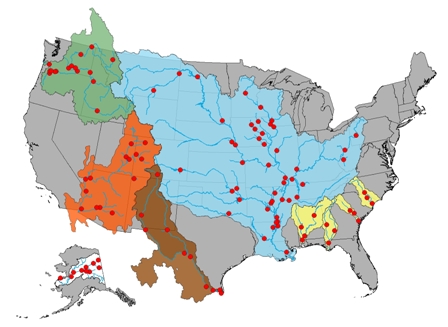|
|
|
|
Biomonitoring of Environmental Status and Trends (BEST)
Large Rivers Monitoring Network (LRMN)
|
| |
The Biomonitoring of Environmental Status and Trends (BEST) Program's Large
River Monitoring Network (LRMN) has examined fish health in multiple river
basins by using a suite of organismal and suborganismal endpoints, which monitor
and assess the effects of environmental contaminants in fish. As a national
monitoring program, BEST-LRMN is unique in that it utilizes biomarkers to
evaluate less persistent chemicals in the environment and to detect
molecular-level changes before population effects may be evident.
|
|
|
|
Click on a basin or on a link below to search
by station number in that basin

|
|
This searchable dataset currently contains
the following information:
-
Contaminant concentrations (elemental and
organochlorines)
-
Fish health indicators (condition
factor, somatic indices, health assessment index, macrophage
aggregate parameters)
-
Reproductive biomarkers (steroid hormones, vitellogenin, gonadal histology)
Biochemical, physiological,
morphological, and histopathological endpoints were chosen to integrate responses at multiple levels of biological
organization. These data have been compared spatially and
temporally by examining trends of various persistent
contaminants and incorporating existing information from other
monitoring efforts.
Links:
Relations Between and Among Contaminant Concentrations and
Biomarkers in Black Bass (Micropterus spp.) and
Common Carp (Cyprinus carpio) in Large U.S. Rivers,
1995-2004 Journal of Environmental Monitoring, Oct 2008
|
|
|
|
|
|
|
|
| |
|
|
|
| |

